#janaloka
Text
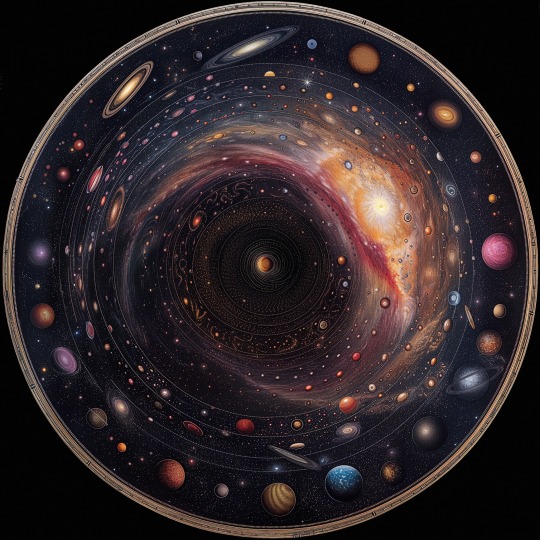
Cosmology by Sri Aurobindo.
A Universe with many worlds (a Multiverse)
We see the world before our eyes, a world with its stars and galaxies and assume that this is the only world which exists. In reality, there also exist many occult worlds of varying gradations of consciousness which are invisible to our physical senses as well as our scientific instruments. A “world” in occult terminology is akin to an energy formation or a formation of consciousness, somewhat like a virtual world populated by beings of its own kind, where the laws of physics are more flexible and where the orders of Time and Space are unlike ours.
Our dreams are transcriptions of travels and interactions in these occult worlds. After death, we cast off our physical body and withdraw into these occult worlds where we reside until the next incarnation. A Yogi who gains occult insight is able to see this vast structure of the Universe. It is precisely this vision which has been described in Chapter 11 of the Bhagavad Gita.
Existence-Consciousness-Bliss (Sachchidananda)
These three worlds are one in essence and are hence called triune. They embody the principles of Sat(Existence), Chit (Consciousness) and Ananda (Bliss). They are also referred to as the Satyaloka, Tapoloka and Janaloka.
Supramental world
Other names for the Supermind:
Maharloka in the Vedas.
Vijnana world in the Upanishads.
rendered as Truth-Consciousness in English by Sri Aurobindo.
The Supermind is the Creator of the phenomenal universe, of the lower worlds of Mind, Life and Matter. It is the medium for self-manifestation of the Supreme or Absolute. It applies some fixed truths, some limiting principles to shape the lower worlds out of an Infinite Consciousness. It creates multiplicity out of unity, differentiation and separation out of pure being.
Three poises of the Supermind
The Supermind has three poises which together result in the creation of Maya (Illusion) in the lower worlds:
Comprehending consciousness(Vijnana) : It holds creation in Unity. This can also be described as the causal state (Karana Avastha)
Apprehending consciousness(Prajnana) : The process of differentiation begins in this poise; it brings about the One in Many and the Many in One. There is separation between Purusha and Prakriti, subject and object, self and not-self but all are still parts of the one. This may also be called the state of expression (Karya Avastha )
Projecting consciousness (Avidya) : Further modification of the second poise so as to support evolution of a diversified individuality. Multiplicity in creation is now fully expressed. This may be called the state of full manifestation (Purna Vyakta Avastha)
36 notes
·
View notes
Text
ॐ
Vedic Cosmology; 3 lokas 14 bhuvanas

According to Vedic philosophy, our soul takes birth in different worlds (realms) based on the Law of Karma. The actions you do from the time you are born in any world to the time you die, your soul carries information, experience, learning valuables, and evolve based on that, vibrating at a certain frequency. Your soul’s frequency will match one of the realms where you will be born.
The Gayatri Mantra has been chronicled in the Rig Veda, in the Atharvaveda, Shiva Puranas and Vishnu Purana (Chapter 7) defines fourteen worlds (not to be confused with planets) seven higher worlds (heavens) and seven lower ones (underworlds). The higher worlds are the seven vyahrtis, viz. bhu, bhuvas, svar, mahas, janas, tapas, and satya (the world that is ruled by Brahma); and the lower ones (the seven underworlds or paatalas) are atala, vitala, sutala, rasaataala, talatala, mahaatala, paatala.
Satya Loka (infinite existence, universe himself); The top of the universe. Brahmanda, the Cosmic Egg, or the Universe. As per many Puranas, the Satya Lioka is the abode of Brahma, the God of Creation. Some Puranas describe Brahma as residing in a Cosmic Egg, the Egg of Brahma or Brahmanda. Vibrates at the highest frequency to anything that will be ever known. Longevity; His current age is 50 years 1st day which is 155.5 trillion human years which is the current age of our universe. God-Level: 100%
Tapa Loka (infinite consciousness, universal presence); 2nd highest part of the universe. At four times the distance, between the two last, lies the Tapo-loka (the sphere of penance), inhabited by the deities called Vaibhrajas, who are unconsumable by fire. Tapo Loka is described as 'greater than' or 'beyond' or 'above' the Jana Loka. It is thus the world of the Galaxies visible to us, including the Milky Way Galaxy. The inhabitants of this world of Galaxies thus would be people belonging to an inter galactic civilization. If the narration is to be believed, they are the deities known as Vaibhrajas who are unconsumable by fire. The beings who live here sometimes act as the bridge to connect the universe and sometimes act as a part of the creator itself. Longevity - from the time of reaching this realm till the time creator exists. God-Level: Between 1%–99%.
Jana Loka (infinite delight, observable universe presence); At twice that distance is situated Janaloka, where Sanandana and other pure-minded sons of Brahma, reside. Jana Loka is described greater than Mahar Loka. It thus contains the Mahar Loka, the world of the stars visible to us. The spirits / beings here have all the knowledge about every realm that exists above and below them, know about existence itself and the universe combined, but are still curious to learn more. They can travel anywhere in the universe at the speed of thought. They (Spirits) don’t even need a physical/any form to exist. They are more than aware (definition of awareness) and lost in the beauty of existence. Longevity - till creator exists. Lifespan - 3.11 trillion years. God-Level: more than 1%.
Mahar Loka / Realm of Heaven: (finite existence, start/reset: inter-galactic presence)- Above Dhruva, at the distance of ton million leagues, lies the sphere of saints, or Mahar-loka, the inhabitants of which dwell in it throughout a Kalpa, or day of Brahma. Maharloka is described as the place of saintly souls (as per Vishnu Purana ch 7) and is considered as greater than the Suvarloka (Heaven or Jannat where ordinary people's souls go after death). The souls of the Saptarshis (Ancient Seven Sages) reside here with a watchful eye upon the activities of humanity on Earth. The world of greatest saints. They are the powerhouse of the galaxy which makes the galaxy/local group exist. They are instincts of heaven. They fully understand the concept of one single soul called Brahman. Inhabitants of Mahar Loka will thus belong to an interstellar civilization. All of the 27 Nakshatras known to the ancient Indians too belongs to this Mahar Loka. Longevity - 3.11 trillion years. Lifespan - avg 4.32 billion years. God-Level: 10^(-5)%.
Svar Loka (finite consciousness, start/reset: galactic presence); Suvar Loka (The Solar System) The interval between the sun and Dhruva, extending fourteen hundred thousand leagues, is called by those who are acquainted with the system of the universe the heavenly sphere (Suvar Loka). Suvar-loka (alternatively Swar-loka) is described as regions of space beyond Bhuvarloka. Some description makes it a planet inhabited by the Devas with their king Indra. Some references make it equivalent to the Swarga (Biblical Heavan, Jannat as described in Quran) where good souls go (after death) to reap the benefits of their good Karma (good deeds). Some Puranic references equate Suvarloka to the Solar System. As per these the Suvar loka is consisted of nine sub divisions or sectors called; Druva Mandala, Sani Mandala, Brihaspati Mandala, Angaraka Mandala, Sukra Mandala, Budha Mandala, Nakshatra Mandala, Chandra Mandala, and Surya Mandala. As for the inhabitants of Suvar Loka, the Human Beings are one among them. The beings here are connected with a single consciousness that limits the possibility of any wrongdoings. It is believed all minor 33 million Hindu Gods live here. Lord Indra rules here. You are free from old age, diseases, etc earth realm worries, and pleasures. However, this realm is occasionally attacked by demons and devils who are jealous of the life here. Some Gods who live here - Vayu Dev (God of Air), Agni Dev (God of Fire), etc. You automatically land in heaven once you accept your non-physical existence completely and are so much in control of yourself that you are able to make new physical objects out of nothing. More like a minor creator. Longevity - 4.32 billion years. Lifespan - up to 306.72 million years. God-Level: 10^(-7)%.
Bhuvar (Pitra) Loka / Realm of Consciousness: (realization of existence, start/reset: solar presence); The air, atmosphere. The beings here don’t have a physical existence but need a medium to exist hence, can live in the air in the form of spirits. They are everywhere on earth and solar system and have to decide whether they are ready to leave the physical world forever and go to Svar Loka or come back to Bhu Loka and live one more life on earth. The beings who come back to the earth realm want to experience physical life as Earth is the last and therefore the most fragile form of physical existence. In this Loka, beings can observe everything - past, present & future of earth but in no way interact with the physical world. Longevity - 306.72 million years. Lifespan - up to 4.32 million years. God-Level: 10^(-8)%.
Bhu Loka (realization of consciousness, start/reset: planetary presence); The realm of earth. The region that extends from the earth to the sun, in which the Siddhas and other celestial beings move, is the atmospheric sphere (Bhuvar Loka). The 6th one viz. Bhuvar-loka is identified with Earth's atmosphere and sometimes with the space which is in the immediate neighborhood of Earth. In other words Bhuvarloka is the near-Earth space including Earth's atmosphere. This is the region where all the aircrafts fly and where all the artificial-satellites and space-stations that orbit around the Earth are situated. This region can re equated to the Geospace, the space dominated by Earth's magnetic field. Vibrates at medium frequency. The realm where attraction to the physical world is still relevant and existing and you can experience it. There are many planets with life that exist in this realm, earth being just one of those. This realm gives a balance between attraction and liberation, prophecy and spirituality. Life on earth is alive for just 12 hours of a day of the creator. The 12 creator hours can be divided into 14 Manvantara and each Manvantara has a total of 71 Yuga cycles. Currently, we are in the 7th Manvantara at the 28th Yuga cycle. Each Yuga cycle longevity - 4.32 million years. For simplicity, 12 creator hours can be divided into 1000 cycles of 4 Yuga.
Realm of Underworld (Unconscious Material World):
Atala Loka (finite lust, start/reset: sub-planetary/lunar presence)- The beings here are immortal, free from old age and diseases, and live a life that they ever wanted to live. Humans, during their early stages of development indeed lived in caves that went as deep as 1 km in the Upper Crust (Atala Loka). Several anomalies and submerged alien space-crafts and submerged-cities are reported as per UFO literature, as situated underground, sometimes beneath the oceans, under the bottom of continental lakes, underground cave networks etc. These are thus located in Atala (Upper Crust) and Vitala (Lower Crust).
Vitala Loka (finite ignorance, start/reset: asteroidal presence)- The beings here generally live longer and healthy life compared to Earth. From the success angle, even the richest on earth will be very small compared to the poorest of this realm. The idea of spirituality is lost here and people are in a never-ending race where at no limit anything is even sufficient for them to give satisfaction. A population of successful people all living a highly dissatisfied life.
Sutala Loka (finite ego, start/reset: sub-asteroidal presence)- The beings are turning evil to satisfy their materialistic pleasures. Right becomes Wrong and Wrong becomes Right. Needless to say, you do the right thing. There is nothing called spirituality. It is all about who gets the highest possession of materialistic pleasures and then calls himself God.
Talatala Loka (finite hallucination, start/reset: granular presence)- The beings here live a kind of similar life as of Atala Loka, the difference is, this time your soul is living in someone else illusion considered to be originating from you. Your soul is literally inside a prison now and completely unaware of it. This doesn’t mean beings won’t be living in a castle made of precious stones built above the cloud.
Mahatala Loka (finite fear, start/reset: molecular presence)- A world populated by Hooded Nagas (Hooded Snakes) who fear Garuda (Eagle). Also, a place where huge snakes suddenly and often appear from underground and anybody can be abducted and killed at any time. Every second is precious. Hence, beings live peacefully with each other. The world is full of imposters though.
Rasatala Loka (finite darkness, start/reset: atomic presence)- The home of devils. This is a world of constant war. If your soul doesn’t move to the above realms, there will be infinite times you will be born and die not a good death, over and over again for materialistic desires. Everybody hates everybody, be it even God. Even after having most of the treasure, life here will be in scarcity.
Patala Loka (finite illusion, start/reset: sub-atomic presence)- The darkest place of all the worlds. The deadliest of the snakes live here. Also, the Richest Realm keeps this world shining. Wore by Nagas themselves. It is perceived differently by different people. The most mysterious Loka of all. Gods say this is the most beautiful realm existing. Demons on the other hand couldn’t even speak what they experienced - like a shattered soul. Therefore, the above 14 Lokas constitute 14 worlds of Brahma (creator) as mentioned in Bhagavata Purana.
Some versions of the vedic texts state that good and bad deeds neutralize each other and the soul therefore is born in either a heaven or a hell, but not both, whereas according to another school of thought, the good and bad deeds don't cancel out each other. In either case, the soul acquires a body as appropriate to the worlds it enters. At the end of the soul's time in those worlds, it returns to the earth (is reborn as a life form on the earth). It is considered that only from the earth, and only after a human life, can the soul reach supreme salvation, the state free from the cycle of birth and death, a state of absolute and eternal bliss.
Your imagination is a reality. It is more attractive than Heaven Realms and in many religions considered to be a true definition of Heaven. However, this is like being locked inside one’s own imagination where after a certain limit, the path/guidance towards true meaning starts becoming desire. Imagine listening to your same favorite music, eating the same favorite food, talking about the same favorite things, etc. The one who wants to seek an answer comes to Bhu Loka. Since there is no pain or sadness here, the value of pleasure and happiness decreases over time, and after a saturation level, being relatively lesser happy than yesterday will be the reason to inflict pain to yourself unknowingly and this keeps growing if not checked. Since pain doesn’t kill, pain may become a new pleasure.
By - Anadi Sahoo
#3loka #14bhuvan #vediccosmology #vedicknowledge #vedicastrology #vedic #VEDICMATHS #ancientindia #ancientwisdom #ancienthistory #ancient #dranadisahoo #BharatMataKiJai
2 notes
·
View notes
Text

Vedic Cosmology; 3 lokas 14 bhuvanas
According to Vedic philosophy, our soul takes birth in different worlds (realms) based on the Law of Karma. The actions you do from the time you are born in any world to the time you die, your soul carries information, experience, learning valuables, and evolve based on that, vibrating at a certain frequency. Your soul’s frequency will match one of the realms where you will be born.
The Gayatri Mantra has been chronicled in the Rig Veda, in the Atharvaveda, Shiva Puranas and Vishnu Purana (Chapter 7) defines fourteen worlds (not to be confused with planets) seven higher worlds (heavens) and seven lower ones (underworlds). The higher worlds are the seven vyahrtis, viz. bhu, bhuvas, svar, mahas, janas, tapas, and satya (the world that is ruled by Brahma); and the lower ones (the seven underworlds or paatalas) are atala, vitala, sutala, rasaataala, talatala, mahaatala, paatala.
Satya Loka (infinite existence, universe himself); The top of the universe. Brahmanda, the Cosmic Egg, or the Universe. As per many Puranas, the Satya Lioka is the abode of Brahma, the God of Creation. Some Puranas describe Brahma as residing in a Cosmic Egg, the Egg of Brahma or Brahmanda. Vibrates at the highest frequency to anything that will be ever known. Longevity; His current age is 50 years 1st day which is 155.5 trillion human years which is the current age of our universe. God-Level: 100%
Tapa Loka (infinite consciousness, universal presence); 2nd highest part of the universe. At four times the distance, between the two last, lies the Tapo-loka (the sphere of penance), inhabited by the deities called Vaibhrajas, who are unconsumable by fire. Tapo Loka is described as 'greater than' or 'beyond' or 'above' the Jana Loka. It is thus the world of the Galaxies visible to us, including the Milky Way Galaxy. The inhabitants of this world of Galaxies thus would be people belonging to an inter galactic civilization. If the narration is to be believed, they are the deities known as Vaibhrajas who are unconsumable by fire. The beings who live here sometimes act as the bridge to connect the universe and sometimes act as a part of the creator itself. Longevity - from the time of reaching this realm till the time creator exists. God-Level: Between 1%–99%.
Jana Loka (infinite delight, observable universe presence); At twice that distance is situated Janaloka, where Sanandana and other pure-minded sons of Brahma, reside. Jana Loka is described greater than Mahar Loka. It thus contains the Mahar Loka, the world of the stars visible to us. The spirits / beings here have all the knowledge about every realm that exists above and below them, know about existence itself and the universe combined, but are still curious to learn more. They can travel anywhere in the universe at the speed of thought. They (Spirits) don’t even need a physical/any form to exist. They are more than aware (definition of awareness) and lost in the beauty of existence. Longevity - till creator exists. Lifespan - 3.11 trillion years. God-Level: more than 1%.
Mahar Loka / Realm of Heaven: (finite existence, start/reset: inter-galactic presence)- Above Dhruva, at the distance of ton million leagues, lies the sphere of saints, or Mahar-loka, the inhabitants of which dwell in it throughout a Kalpa, or day of Brahma. Maharloka is described as the place of saintly souls (as per Vishnu Purana ch 7) and is considered as greater than the Suvarloka (Heaven or Jannat where ordinary people's souls go after death). The souls of the Saptarshis (Ancient Seven Sages) reside here with a watchful eye upon the activities of humanity on Earth. The world of greatest saints. They are the powerhouse of the galaxy which makes the galaxy/local group exist. They are instincts of heaven. They fully understand the concept of one single soul called Brahman. Inhabitants of Mahar Loka will thus belong to an interstellar civilization. All of the 27 Nakshatras known to the ancient Indians too belongs to this Mahar Loka. Longevity - 3.11 trillion years. Lifespan - avg 4.32 billion years. God-Level: 10^(-5)%.
Svar Loka (finite consciousness, start/reset: galactic presence); Suvar Loka (The Solar System) The interval between the sun and Dhruva, extending fourteen hundred thousand leagues, is called by those who are acquainted with the system of the universe the heavenly sphere (Suvar Loka). Suvar-loka (alternatively Swar-loka) is described as regions of space beyond Bhuvarloka. Some description makes it a planet inhabited by the Devas with their king Indra. Some references make it equivalent to the Swarga (Biblical Heavan, Jannat as described in Quran) where good souls go (after death) to reap the benefits of their good Karma (good deeds). Some Puranic references equate Suvarloka to the Solar System. As per these the Suvar loka is consisted of nine sub divisions or sectors called; Druva Mandala, Sani Mandala, Brihaspati Mandala, Angaraka Mandala, Sukra Mandala, Budha Mandala, Nakshatra Mandala, Chandra Mandala, and Surya Mandala. As for the inhabitants of Suvar Loka, the Human Beings are one among them. The beings here are connected with a single consciousness that limits the possibility of any wrongdoings. It is believed all minor 33 million Hindu Gods live here. Lord Indra rules here. You are free from old age, diseases, etc earth realm worries, and pleasures. However, this realm is occasionally attacked by demons and devils who are jealous of the life here. Some Gods who live here - Vayu Dev (God of Air), Agni Dev (God of Fire), etc. You automatically land in heaven once you accept your non-physical existence completely and are so much in control of yourself that you are able to make new physical objects out of nothing. More like a minor creator. Longevity - 4.32 billion years. Lifespan - up to 306.72 million years. God-Level: 10^(-7)%.
Bhuvar (Pitra) Loka / Realm of Consciousness: (realization of existence, start/reset: solar presence); The air, atmosphere. The beings here don’t have a physical existence but need a medium to exist hence, can live in the air in the form of spirits. They are everywhere on earth and solar system and have to decide whether they are ready to leave the physical world forever and go to Svar Loka or come back to Bhu Loka and live one more life on earth. The beings who come back to the earth realm want to experience physical life as Earth is the last and therefore the most fragile form of physical existence. In this Loka, beings can observe everything - past, present & future of earth but in no way interact with the physical world. Longevity - 306.72 million years. Lifespan - up to 4.32 million years. God-Level: 10^(-8)%.
Bhu Loka (realization of consciousness, start/reset: planetary presence); The realm of earth. The region that extends from the earth to the sun, in which the Siddhas and other celestial beings move, is the atmospheric sphere (Bhuvar Loka). The 6th one viz. Bhuvar-loka is identified with Earth's atmosphere and sometimes with the space which is in the immediate neighborhood of Earth. In other words Bhuvarloka is the near-Earth space including Earth's atmosphere. This is the region where all the aircrafts fly and where all the artificial-satellites and space-stations that orbit around the Earth are situated. This region can re equated to the Geospace, the space dominated by Earth's magnetic field. Vibrates at medium frequency. The realm where attraction to the physical world is still relevant and existing and you can experience it. There are many planets with life that exist in this realm, earth being just one of those. This realm gives a balance between attraction and liberation, prophecy and spirituality. Life on earth is alive for just 12 hours of a day of the creator. The 12 creator hours can be divided into 14 Manvantara and each Manvantara has a total of 71 Yuga cycles. Currently, we are in the 7th Manvantara at the 28th Yuga cycle. Each Yuga cycle longevity - 4.32 million years. For simplicity, 12 creator hours can be divided into 1000 cycles of 4 Yuga.
Realm of Underworld (Unconscious Material World):
Atala Loka (finite lust, start/reset: sub-planetary/lunar presence)- The beings here are immortal, free from old age and diseases, and live a life that they ever wanted to live. Humans, during their early stages of development indeed lived in caves that went as deep as 1 km in the Upper Crust (Atala Loka). Several anomalies and submerged alien space-crafts and submerged-cities are reported as per UFO literature, as situated underground, sometimes beneath the oceans, under the bottom of continental lakes, underground cave networks etc. These are thus located in Atala (Upper Crust) and Vitala (Lower Crust).
Vitala Loka (finite ignorance, start/reset: asteroidal presence)- The beings here generally live longer and healthy life compared to Earth. From the success angle, even the richest on earth will be very small compared to the poorest of this realm. The idea of spirituality is lost here and people are in a never-ending race where at no limit anything is even sufficient for them to give satisfaction. A population of successful people all living a highly dissatisfied life.
Sutala Loka (finite ego, start/reset: sub-asteroidal presence)- The beings are turning evil to satisfy their materialistic pleasures. Right becomes Wrong and Wrong becomes Right. Needless to say, you do the right thing. There is nothing called spirituality. It is all about who gets the highest possession of materialistic pleasures and then calls himself God.
Talatala Loka (finite hallucination, start/reset: granular presence)- The beings here live a kind of similar life as of Atala Loka, the difference is, this time your soul is living in someone else illusion considered to be originating from you. Your soul is literally inside a prison now and completely unaware of it. This doesn’t mean beings won’t be living in a castle made of precious stones built above the cloud.
Mahatala Loka (finite fear, start/reset: molecular presence)- A world populated by Hooded Nagas (Hooded Snakes) who fear Garuda (Eagle). Also, a place where huge snakes suddenly and often appear from underground and anybody can be abducted and killed at any time. Every second is precious. Hence, beings live peacefully with each other. The world is full of imposters though.
Rasatala Loka (finite darkness, start/reset: atomic presence)- The home of devils. This is a world of constant war. If your soul doesn’t move to the above realms, there will be infinite times you will be born and die not a good death, over and over again for materialistic desires. Everybody hates everybody, be it even God. Even after having most of the treasure, life here will be in scarcity.
Patala Loka (finite illusion, start/reset: sub-atomic presence)- The darkest place of all the worlds. The deadliest of the snakes live here. Also, the Richest Realm keeps this world shining. Wore by Nagas themselves. It is perceived differently by different people. The most mysterious Loka of all. Gods say this is the most beautiful realm existing. Demons on the other hand couldn’t even speak what they experienced - like a shattered soul. Therefore, the above 14 Lokas constitute 14 worlds of Brahma (creator) as mentioned in Bhagavata Purana.
Some versions of the vedic texts state that good and bad deeds neutralize each other and the soul therefore is born in either a heaven or a hell, but not both, whereas according to another school of thought, the good and bad deeds don't cancel out each other. In either case, the soul acquires a body as appropriate to the worlds it enters. At the end of the soul's time in those worlds, it returns to the earth (is reborn as a life form on the earth). It is considered that only from the earth, and only after a human life, can the soul reach supreme salvation, the state free from the cycle of birth and death, a state of absolute and eternal bliss.
Your imagination is a reality. It is more attractive than Heaven Realms and in many religions considered to be a true definition of Heaven. However, this is like being locked inside one’s own imagination where after a certain limit, the path/guidance towards true meaning starts becoming desire. Imagine listening to your same favorite music, eating the same favorite food, talking about the same favorite things, etc. The one who wants to seek an answer comes to Bhu Loka. Since there is no pain or sadness here, the value of pleasure and happiness decreases over time, and after a saturation level, being relatively lesser happy than yesterday will be the reason to inflict pain to yourself unknowingly and this keeps growing if not checked. Since pain doesn’t kill, pain may become a new pleasure.
By - Anadi Sahoo
4 notes
·
View notes
Text
SUPAYA jadi sumber energi bagi jiwa Janaloka. Yang dengan kasih terpatri, dari kami, Samata.
Bagian iv
















0 notes
Text
DAILY WISDOM - 203 : 21. The Person who Renounces the World is a Part of the World / నిత్య ప్రజ్ఞా సందేశములు - 203 : 21. ప్రపంచాన్ని త్యజించే వ్యక్తి ప్రపంచంలో ఒక భాగమే
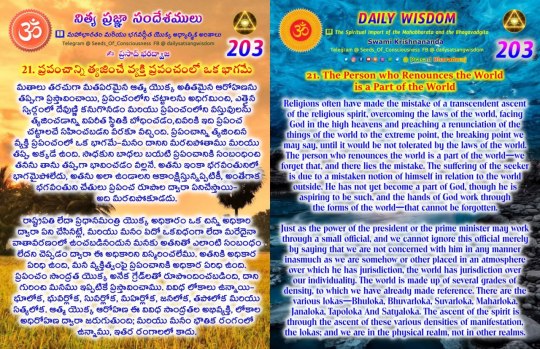
🌹. నిత్య ప్రజ్ఞా సందేశములు - 203 / DAILY WISDOM - 203 🌹
🍀 📖 మహాభారతం మరియు భగవద్గీత యొక్క ఆధ్యాత్మిక అంశాలు 🍀
✍️. ప్రసాద్ భరద్వాజ
🌻 21. ప్రపంచాన్ని త్యజించే వ్యక్త��� ప్రపంచంలో ఒక భాగమే 🌻
మతాలు తరచుగా మతపరమైన ఆత్మ యొక్క అతీతమైన ఆరోహణను తప్పుగా ప్రస్తావించాయి, ప్రపంచంలోని చట్టాలను అధిగమించి, ఎత్తైన స్వర్గంలో దేవుణ్ణి కనుగొనడం మరియు ప్రపంచంలోని వస్తువులను త్యజించడాన్ని విపరీత స్థితికి బోధించడం,చివరికి ఇది ప్రపంచ చట్టాలచే సహించబడని వరకూ వచ్చింది. ప్రపంచాన్ని త్యజించిన వ్యక్తి ప్రపంచంలో ఒక భాగమే-మనం దానిని మరచిపోతాము మరియు తప్పు అక్కడే ఉంది. సాధకుని బాధలు బయటి ప్రపంచానికి సంబంధించి తనను తాను తప్పుగా భావించడం వల్లనే. అతను ఇంకా భగవంతునిలో భాగమైపోలేదు, అతను అలా ఉండాలని ఆకాంక్షిస్తున్నప్పటికీ, అంతేగాక భగవంతుని చేతులు ప్రపంచ రూపాల ద్వారా పనిచేస్తాయి-అది మరచిపోకూడదు.
రాష్ట్రపతి లేదా ప్రధానమంత్రి యొక్క అధికారం ఒక చిన్న అధికారి ద్వారా పని చేసినట్లే, మరియు మనం ఏదో ఒకవిధంగా లేదా మరేదైనా వాతావరణంలో ఉంచబడినందున మనకు అతనితో ఎలాంటి సంబంధం లేదని చెప్పడం ద్వారా ఈ అధికారిని విస్మరించలేము. అతనికి అధికార పరిధి ఉంది, మన వ్యక్తిత్వంపై ప్రపంచానికి అధికార పరిధి ఉంది. ప్రపంచం సాంద్రత యొక్క అనేక గ్రేడ్లతో రూపొందించబడింది, దాని గురించి మనము ఇప్పటికే ప్రస్తావించాము. వివిధ లోకాలు ఉన్నాయి-భూలోక, భువర్లోక, సువర్లోక, మహర్లోక, జనలోక, తపోలోక మరియు సత్యలోక. ఆత్మ యొక్క ఆరోహణ ఈ వివిధ సాంద్రతల అభివ్యక్తి, లోకాల అధిరోహణ ద్వారా జరుగుతుంది; మరియు మనం భౌతిక రంగంలో ఉన్నాము, ఇతర రంగాలలో కాదు.
కొనసాగుతుంది...
🌹 🌹 🌹 🌹 🌹

🌹 DAILY WISDOM - 203 🌹
🍀 📖 The Spiritual Import of the Mahabharata and the Bhagavadgita 🍀
📝 Swami Krishnananda
📚. Prasad Bharadwaj
🌻 21. The Person who Renounces the World is a Part of the World 🌻
Religions often have made the mistake of a transcendent ascent of the religious spirit, overcoming the laws of the world, facing God in the high heavens and preaching a renunciation of the things of the world to the extreme point, the breaking point we may say, until it would be not tolerated by the laws of the world. The person who renounces the world is a part of the world—we forget that, and there lies the mistake. The suffering of the seeker is due to a mistaken notion of himself in relation to the world outside. He has not yet become a part of God, though he is aspiring to be such, and the hands of God work through the forms of the world—that cannot be forgotten.
Just as the power of the president or the prime minister may work through a small official, and we cannot ignore this official merely by saying that we are not concerned with him in any manner inasmuch as we are somehow or other placed in an atmosphere over which he has jurisdiction, the world has jurisdiction over our individuality. The world is made up of several grades of density, to which we have already made reference. There are the various lokas—Bhuloka, Bhuvarloka, Suvarloka, Maharloka, Janaloka, Tapoloka And Satyaloka. The ascent of the spirit is through the ascent of these various densities of manifestation, the lokas; and we are in the physical realm, not in other realms.
Continues...
🌹 🌹 🌹 🌹 🌹
0 notes
Text
KISAH PANJANG
JANALOKA ㅡ "Kisah hidup tujuh remaja satu komplek dengan segala bentuk keanehannya"
0 notes
Photo

यज्ञैरिष्ट्वा स्वर्गतिं प्रार्थयन्ते | ते पुण्यमासाद्य सुरेन्द्रलोक- मश्र्नन्ति दिव्यान्दिवि देवभोगान् || २० || trai-vidyā māṁ soma-pāḥ pūta-pāpā yajñair iṣṭvā svar-gatiṁ prārthayante te puṇyam āsādya surendra-lokam aśnanti divyān divi deva-bhogān Those who study the Vedas and drink the soma juice, seeking the heavenly planets, worship Me indirectly. They take birth on the planet of Indra, where they enjoy godly delights. The word trai-vidyāḥ refers to the three Vedas, Sāma, Yajur and Ṛg. A brāhmaṇa who has studied these three Vedas is called a tri-vedī. Anyone who is very much attached to knowledge derived from these three Vedas is respected in society. Unfortunately, there are many great scholars of the Vedas who do not know the ultimate purport of studying them. Therefore Kṛṣṇa herein declares Himself to be the ultimate goal for the tri-vedīs. Actual tri-vedīs take shelter under the lotus feet of Kṛṣṇa and engage in pure devotional service to satisfy the Lord. Devotional service begins with the chanting of the Hare Kṛṣṇa mantra and side by side trying to understand Kṛṣṇa in truth. Unfortunately those who are simply official students of the Vedas become more interested in offering sacrifices to the different demigods like Indra, Candra, etc. By such endeavor, the worshipers of different demigods are certainly purified of the contamination of the lower qualities of nature and are thereby elevated to the higher planetary system or heavenly planets known as Maharloka, Janaloka, Tapoloka, etc. Once situated on those higher planetary systems, one can satisfy his senses hundreds of thousands of times better than on this planet. https://gloriousgita.com/verse/en/9/20 https://bhagavad-gita.org/Gita/verse-09-20.html https://bookchanges.com/wp-content/uploads/2009/09/Bg-Chapter-9-diff.htm https://youtube.com/c/HearSrilaPrabhupada https://www.bhagavad-gita.us/famous-reflections-on-the-bhagavad-gita/ https://sites.google.com/view/sanatan-dharma https://m.facebook.com/HDG.A.C.Bhaktivedanta.Svami.Srila.Prabhupada.Uvaca/ #bhagavatam #srimadbhagavatam #vishnu #vishnupuran #harekrishna #harekrsna #harekrishna #harekrisna #prabhupada #bhagavadgita https://www.instagram.com/p/Cn_oeBZrV7A/?igshid=NGJjMDIxMWI=
#bhagavatam#srimadbhagavatam#vishnu#vishnupuran#harekrishna#harekrsna#harekrisna#prabhupada#bhagavadgita
1 note
·
View note
Text
Another Nakshatra system, the 28 Nakshatra plan, enters the picture when it comes to spiritual worlds. A hypothetical square with seven sets of steps on each side serves as a representation for this. Maharloka, Janaloka, Tapoloka, and Swargaloka represent each side. The name of this square is Chok or Jagannath. If one knows Orissa dance, which is based on Chok, they will know that it is a very spiritual dance.
There are 2.25 Nakshatras in each zodiac. That translates to two Nakshatras and one-fourth of the third Nakshatra after that. As a result, each zodiac has nine Padas because each Nakshatra has four of them. Nakshatra lords, often known as deities, are vital in defining the planetary motivation of inhabitants. To a certain extent, they alter planetary influences.
Read all about nakshatra astrology and get detailed insights into its types and significance on our life.
#astrologers#astrology#constellations#nakshatra#28nakshatra#online astrologers#talk to astrologers#horoscope
1 note
·
View note
Text
Jum'at, 10 Juni 2022. 11.30am.
Akhirnya, kebeli juga 2 buku yang aku incar.
Titik Temu by Ghyna Amanda dan Namaku Hiroko by Nh. Dini. Alhamdulillah, walaupun buku bekas, yang penting bukan buku bajakan ya. Bukan buku fotokopian 🤩
Harganya juga murah, untuk Titik Temu terbitan 2017, aku beli di Janaloka Bookstore di Shoppee, harga Rp 35.000. Untuk Namaku Hiroko terbitan 1986/87, aku beli di Tokopedia, harga Rp 60.000.
Aku jadi bertanya-tanya, sebenernya, pekerjaan apa yang cocok untuk ibu rumah tangga usia 32 tahun, yang gemar novel?. Terutama novel-novel dengan latar belakang sejarah, suka banget aku.
Apa yang harus aku lakukan dengan novel-novelku ini? Dijual lagi setelah dibaca? Aku rasa tidak ya. Alasan kenapa aku mau memiliki buku yang sudah tidak diterbitkan lagi, karena aku ingin mengoleksinya. Uups, bahasaku terlalu formal disini.
Begitulah, rasanya emang harus terus mencari dan mencoba hal-hal baru.
0 notes
Photo

Salah satu pengkerdilan terkejam dalam hidup adalah membiarkan pikiran yang cemerlang menjadi budak bagi tubuh yang malas, yang mendahulukan istirahat sebelum lelah. . Buya Hamka 🌿🌿🌿 _____________________ #buyahamka #hamka #quote #sinauurip #uripikuurup #urupkeurip #kahuripan #janaloka #_janaloka_ #traditional #home #house #javanese #local #haritage #java #indonesian #tour #village #photohouse #rumah #pulang #jalanpulang
#buyahamka#village#java#javanese#local#photohouse#house#traditional#pulang#hamka#urupkeurip#janaloka#sinauurip#uripikuurup#kahuripan#haritage#rumah#jalanpulang#tour#home#quote#_janaloka_#indonesian
1 note
·
View note
Photo
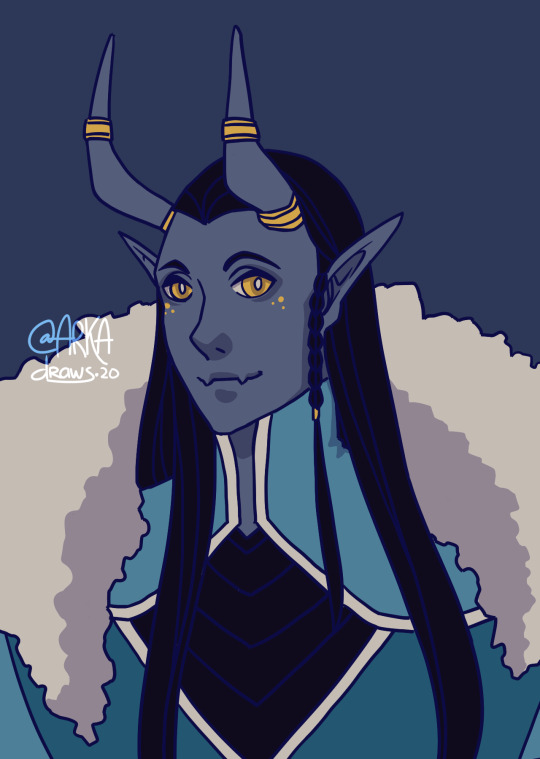
Prince Ahrean of the Craernoids. he's one of the protags of my newest original novel, Rana Janaloka
COMMISSION IS OPEN!! help me get a new drawing tablet pls 🙏
15 notes
·
View notes
Text
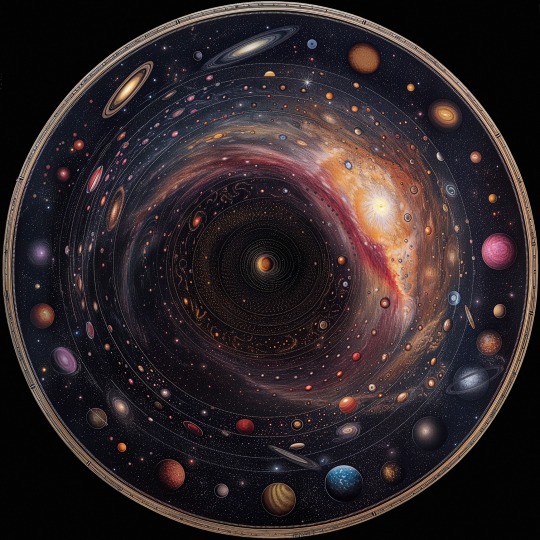
Sat-Chit-Ananda
The Integral Cosmology of Sri Aurobindo
A Universe with many worlds (a Multiverse)
We see the world before our eyes, a world with its stars and galaxies and assume that this is the only world which exists. In reality, there also exist many occult worlds of varying gradations of consciousness which are invisible to our physical senses as well as our scientific instruments. A “world” in occult terminology is akin to an energy formation or a formation of consciousness, somewhat like a virtual world populated by beings of its own kind, where the laws of physics are more flexible and where the orders of Time and Space are unlike ours.
Our dreams are transcriptions of travels and interactions in these occult worlds. After death, we cast off our physical body and withdraw into these occult worlds where we reside until the next incarnation. A Yogi who gains occult insight is able to see this vast structure of the Universe. It is precisely this vision which has been described in Chapter 11 of the Bhagavad Gita.
Existence-Consciousness-Bliss (Sachchidananda)
These three worlds are one in essence and are hence called triune. They embody the principles of Sat(Existence), Chit (Consciousness) and Ananda (Bliss). They are also referred to as the Satyaloka, Tapoloka and Janaloka.
Supramental world
Other names for the Supermind:
Maharloka in the Vedas.
Vijnana world in the Upanishads.
rendered as Truth-Consciousness in English by Sri Aurobindo.
The Supermind is the Creator of the phenomenal universe, of the lower worlds of Mind, Life and Matter. It is the medium for self-manifestation of the Supreme or Absolute. It applies some fixed truths, some limiting principles to shape the lower worlds out of an Infinite Consciousness. It creates multiplicity out of unity, differentiation and separation out of pure being.
Cosmology
Three poises of the Supermind
The Supermind has three poises which together result in the creation of Maya (Illusion) in the lower worlds:
Comprehending consciousness(Vijnana) : It holds creation in Unity. This can also be described as the causal state (Karana Avastha)
Apprehending consciousness(Prajnana) : The process of differentiation begins in this poise; it brings about the One in Many and the Many in One. There is separation between Purusha and Prakriti, subject and object, self and not-self but all are still parts of the one. This may also be called the state of expression (Karya Avastha )
Projecting consciousness (Avidya) : Further modification of the second poise so as to support evolution of a diversified individuality. Multiplicity in creation is now fully expressed. This may be called the state of full manifestation (Purna Vyakta Avastha)
43 notes
·
View notes
Text
The Purāṇas speak of 400,000 humanlike races of beings living on various planets and of 8,000,000 other life forms, including plants and lower animals. Out of the 400,000 humanlike forms, human beings as we know them are said to be among the least powerful. This, of course, ties in with the picture that emerges from accounts of UFO encounters. I have been using the word “humanoid” to refer to humanlike beings reported in UFO encounters, and I will also use it to refer to the Vedic humanlike races.
UFO accounts often portray humanoids as looking strange or repulsive, but some have been described as beautiful. The Vedic humanoids also vary widely in appearance. Some of them, such as Gandharvas and Siddhas, are said to have very beautiful human forms. Others are said to be ugly, frightening, or deformed in appearance. One group is called the Kimpuruṣas. Here kim means “is it?,” and puruṣa means “human.”
Many of the Vedic humanoid races are said to naturally possess certain powers called siddhis. Humans of this earth can also potentially acquire these powers, and some people have greater abilities in this regard than others. Here is a list of some of these siddhis. Since they seem to be directly related to some of the powers attributed to UFO entities, I will discuss them in greater detail in later sections.
1. Mental communication and thought-reading. These are standard among Vedic humanoids, but normal speech through sound is also generally used.
2. Being able to see or hear at a great distance.
3. Laghimā-siddhi: levitation or antigravity. There is also a power of creating enormous weight.
4. Aṇimā- and mahimā-siddhis: the power to change the size of objects or living bodies without disrupting their structure.
5. Prāpti-siddhi: the power to move objects from one place to another, apparently without crossing the intervening space. This power is connected with the ability to travel into parallel, higher-dimensional realms.
6. The ability to move objects directly through the ether, without being impeded by gross physical obstacles. This type of travel is called vihāyasa. There is also a type of travel called mano-java, in which the body is directly transferred to a distant point by the action of the mind.
7. Vaśitā-siddhi: the power of long-distance hypnotic control. Vedic accounts point out that this power can be used to control people’s thoughts from a distance.
8. Antardhāna, or invisibility.
9. The ability to assume different forms or to generate illusory bodily forms.
10. The power of entering within another person’s body and controlling it. This is done using the subtle body (defined below).
Many different Vedic humanoid races are said to live in parallel, higher-dimensional realms within the earth, on its surface, and in its immediate vicinity. One striking feature of Vedic accounts is that different races such as Siddhas, Cāraṇas, Uragas, Guhyakas, and Vidyādharas are often described as living and working together cooperatively, even though they differ greatly in customs and appearance. These beings are generally well endowed with the various siddhis.
In the past, many of these humanoid types were to be found on the earth, either as visitors or as inhabitants. Indeed, large areas of the earth’s surface have sometimes been controlled and populated by a variety of humanoid species. This is the basic setting of the Rāmāyaṇa,which tells how Lord Rāmacandra rescued his wife Sītā from the kingdom of Laṅkā, to which she had been taken by a Rākṣasa named Rāvaṇa. The Rākṣasas are one of the 400,000 humanoid races, and they were ruling Laṅkā at that time.
In the Vedic cosmic hierarchy, there is a graded series of higher planetary systems, each of which is inaccessible to the inhabitants of the systems below it. The topmost authority in the material universe is known as Brahmā, and he lives in the highest material planetary system, called Brahmaloka. Beneath Brahmaloka there are the planetary systems Tapoloka, Janaloka, and Maharloka, which are inhabited by sages (ṛṣis) who live as ascetics and cultivate knowledge and transcendental consciousness. Beneath these planets, there is the realm of Svargaloka, which is predominated by the beings known as Devas. The Devas are organized in a military hierarchy. They engage in politics and warfare, and their battles with lower forces may sometimes have an impact on life on the earth. However, due to the extremely long life spans of the Devas, their social and political relationships tend to be stable.
Although the universe is completely under intelligent control, higher-level controllers such as the Devas and great sages do not generally intervene directly in the lives of subordinate beings, including earthly humans. Rather they make arrangements for these beings to transmigrate from body to body according to their work, and thereby allow for their gradual evolution in consciousness. They also make arrangements for the dissemination of spiritual teachings in various societies so as to guide embodied souls in the direction of higher spiritual development. According to the Vedic perspective, spiritual advancement should be the main goal of human life.
Among the different humanoid types, there are races who have an essentially self-centered outlook. These are distinguished from those who tend to be dedicated to the service of the Supreme Being and the cosmic hierarchy. Some are like celestial playboys who live in great opulence. Others are characterized by an alienated state of consciousness, and yet others are strongly inimical. The self-centered races tend to be greatly attracted to the exploitation of mystic powers and technology.
All of these different groups of beings are under the control of the universal hierarchy, and thus they are not able to act fully according to their own propensities. This would explain why we are not simply taken over by them. However, there are beings who actively rebel against the cosmic hierarchy and who do sometimes interfere strongly in earthly affairs.
The most famous rebels are the Asuras, who are close relatives of the Devas. The Purāṇas describe protracted wars in Svargaloka between the Devas and the Asuras, and the basic plot of the Mahābhārata has to do with an invasion of the earth by the Asuras...
Since the Devas are beings of a godly nature who hold administrative posts in the universal hierarchy, the word “demigod,” taken from classical Greek and Roman mythology, is often used to refer to them. In contrast, the rebellious Asuras are often referred to as “demons,” since they tend to be atheistic and to oppose the divine order. Actually, the word “demon” acquired its negative connotations under the influence of Christianity. This word comes from “daemon,” which in classical Roman times meant a being intermediate between the demigods and man. The Romans and Greeks thought that there were many types of beings in this category, and these were not all regarded as evil or “demonic.” The Vedic literature also describes many races intermediate between the Devas and human beings, and these include the Vidyādharas, Uragas, and Rākṣasas. The Rākṣasas are demonic and highly inimical to humans. The Vidyādharas and Uragas are essentially neutral—they cooperate with the universal hierarchy, but they have their own agendas to pursue, and they neither favor nor oppose the human race. They belong to a category of beings known as Upadevas, or almost-Devas.
-- Richard L. Thompson, Parallels: Ancient Insights into Modern UFO Phenomena
9 notes
·
View notes
Photo
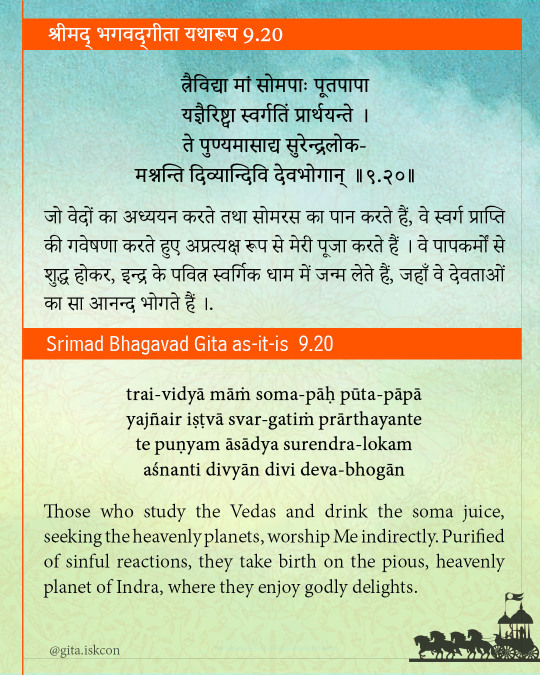
श्रीमद् भगवद्गीता यथारूप 9.20 त्रैविद्या मां सोमपाः पूतपापा यज्ञैरिष्ट्वा स्वर्गतिं प्रार्थयन्ते । ते पुण्यमासाद्य सुरेन्द्रलोक- मश्नन्ति दिव्यान्दिवि देवभोगान् ॥ ९.२० ॥ TRANSLATION जो वेदों का अध्ययन करते तथा सोमरस का पान करते हैं, वे स्वर्ग प्राप्ति की गवेषणा करते हुए अप्रत्यक्ष रूप से मेरी पूजा करते हैं । वे पापकर्मों से शुद्ध होकर, इन्द्र के पवित्र स्वर्गिक धाम में जन्म लेते हैं, जहाँ वे देवताओं का सा आनन्द भोगते हैं ।. PURPORT त्रैविद्याः शब्द तीन वेदों – साम, यजुः तथा ऋग्वेद – का सूचक है । जिस ब्राह्मण ने इन तीनों वेदों का अध्ययन किया है वह त्रिवेदी कहलाता है । जो इन तीनों वेदों से प्राप्त ज्ञान के प्रति आसक्त रहता है, इसका समाज में आदर होता है । दुर्भाग्यवश वेदों के ऐसे अनेक पण्डित हैं जो उनके अध्ययन के चरमलक्ष्य को नहीं समझते । इसीलिए कृष्ण अपने को त्रिवेदियों के लिए परमलक्ष्य घोषित करते हैं । वास्तविक त्रिवेदी भगवान् के चरणकमलों की शरण ग्रहण करते हैं और भगवान् को प्रसन्न करने के लिए उनकी शुद्धभक्ति करते हैं । भक्ति का सूत्रपात हरे कृष्ण मन्त्र के कीर्तन तथा साथ-साथ कृष्ण को वास्तव में समझने के प्रयास से होता है । दुर्भाग्यवश जो लोग वेदों के नाममात्र के छात्र हैं वे इन्द्र तथा चन्द्र जैसे विभिन्न देवों को आहुति प्रदान करने में रूचि लेते हैं । ऐसे प्रयत्न से विभिन्न देवों के उपासक निश्चित रूप से प्रकृति के निम्न गुणों के कल्मष से शुद्ध हो जाते हैं । फलस्वरूप वे उच्चतर लोकों, यथा महर्लोक, जनलोक, तपलोक आदि को प्र��प्त होते हैं । एक बार इन ��च्च लोकों में पहुँच कर वहाँ इस लोक की तुलना में लाखों गुणा अच्छी तरह इन्द्रियों की तुष्टि की जा सकती है । ----- Srimad Bhagavad Gita As It Is 9.20 trai-vidyā māṁ soma-pāḥ pūta-pāpā yajñair iṣṭvā svar-gatiṁ prārthayante te puṇyam āsādya surendra-lokam aśnanti divyān divi deva-bhogān TRANSLATION Those who study the Vedas and drink the soma juice, seeking the heavenly planets, worship Me indirectly. Purified of sinful reactions, they take birth on the pious, heavenly planet of Indra, where they enjoy godly delights. PURPORT The word trai-vidyāḥ refers to the three Vedas – Sāma, Yajur and Ṛg. A brāhmaṇa who has studied these three Vedas is called a tri-vedī. Anyone who is very much attached to knowledge derived from these three Vedas is respected in society. Unfortunately, there are many great scholars of the Vedas who do not know the ultimate purport of studying them. Therefore Kṛṣṇa herein declares Himself to be the ultimate goal for the tri-vedīs. Actual tri-vedīs take shelter under the lotus feet of Kṛṣṇa and engage in pure devotional service to satisfy the Lord. Devotional service begins with the chanting of the Hare Kṛṣṇa mantra and side by side trying to understand Kṛṣṇa in truth. Unfortunately those who are simply official students of the Vedas become more interested in offering sacrifices to the different demigods like Indra and Candra. By such endeavor, the worshipers of different demigods are certainly purified of the contamination of the lower qualities of nature and are thereby elevated to the higher planetary systems or heavenly planets known as Maharloka, Janaloka, Tapoloka, etc. Once situated on those higher planetary systems, one can satisfy his senses hundreds of thousands of times better than on this planet. -----
3 notes
·
View notes
Text
SUPAYA jadi sumber energi bagi jiwa Janaloka. Yang dengan kasih terpatri, dari kami, Samata.
Bagian iii
























0 notes
Text
శ్రీమద్భగవద్గీత - 358: 09వ అధ్., శ్లో 20 / Bhagavad-Gita - 358: Chap. 09, Ver. 20

🌹. శ్రీమద్భగవద్గీత - 358 / Bhagavad-Gita - 358 🌹
✍️. శ్రీ ప్రభుపాద, 📚. ప్రసాద్ భరద్వాజ
🌴. 9వ అధ్యాయము - రాజవిద్యా రాజగుహ్య యోగం - 20 🌴
20. త్రైవిద్యా మాం సోమపా: పూతపాపా యజ్ఞైరష్ట్వా స్వర్గతిం ప్రార్థయన్తే |
తే పుణ్యమాసాద్య సురేద్రలోకమ్ అశ్నన్తి దివ్యాన్దివి దేవా భోగాన్ ||
🌷. తాత్పర్యం :
స్వర్గలోకములను గోరుచు వేదాధ్యయనము చేయువారు మరియు సోమరసమును పానము చేయువారు పరోక్షముగా నన్నే అర్చింతురు. పాపఫలముల నుండి పవిత్రులై అట్టివారు పుణ్య ఇంద్రలోకమున జన్మించి దేవభోగముల ననుభవింతురు.
🌷. భాష్యము :
ఈ శ్లోకము నందలి “త్రైవిద్యా:” అను పదము సామవేదము, యజుర్వేదము, ఋగ్వేదములను సూచించుచున్నది. ఇట్టి మూడు వేదములను అధ్యయనము చేసిన బ్రహ్మణుడే “త్రివేది” యని పిలువబడును. ��� వేదములందు తెలుపబడిన జ్ఞానము యెడ ఆకర్షణను కలిగియుండువాడు నిక్కముగా సంఘములో అత్యంత గౌరవనీయుడు కాగలడు. కాని దురదృష్టవశాత్తు వేదాధ్యయనపు అంతిమ ప్రయోజనమును తెలియని వేదపండితులే అధికముగా నున్నారు. కనుకనే ఆ త్రివేదులకు అంతిమలక్ష్యము తానేయని శ్రీకృష్ణభగవానుడు ఇచ్చట ప్రకటించుచున్నాడు. నిజమైన త్రివేదులు శ్రీకృష్ణభగవానుని చరణకమలములకు శరణమునొంది అతని ప్రీత్యర్థమై భక్తియుక్తసేవలో నియుక్తులగుదురు.
అట్టి భక్తియోగము హరేకృష్ణ మహామంత్రమును జపించుటతోను మరియు అదేసమయమున కృష్ణుని గూర్చి నిజముగా అవగతము చేసికొనుట యత్నించుటతోను ఆరంభమగును. కాని దురదృష్టవశాత్తు వేదాధ్యయనపరులు సాధారణముగా ఇంద్రుడు, చంద్రుడు వంటి దేవతల కొరకు యజ్ఞములు చేయుట యందే మగ్నులగుదురు. అట్టి యత్నముచే వివిధ దేవతార్చకులు నిక్కముగా రజస్తమోగుణ సంపర్కము నుండి శుద్ధిపడినవారై మహర్లోకము, జనలోకము, తపోలోకము పలు ఊర్థ్వలోకములను(స్వర్గలోకములను) చేరుదురు. అట్టి ఉన్నతలోకములను చేరిన పిమ్మట వారు భూలోకమున్నను అనేక లక్షలరెట్లు అధికముగా సుఖముల ననుభవింతురు.
🌹 🌹 🌹 🌹 🌹
🌹 Bhagavad-Gita as It is - 358 🌹
✍️ Sri Prabhupada, 📚 Prasad Bharadwaj
🌴 Chapter 9 - Raja Vidya Raja Guhya Yoga - 20 🌴
20. trai-vidyā mā�� soma-pāḥ pūta-pāpā yajñair iṣṭvā svar-gatiṁ prārthayante
te puṇyam āsādya surendra-lokam aśnanti divyān divi deva-bhogān
🌷 Translation :
Those who study the Vedas and drink the soma juice, seeking the heavenly planets, worship Me indirectly. Purified of sinful reactions, they take birth on the pious, heavenly planet of Indra, where they enjoy godly delights.
🌹 Purport :
The word trai-vidyāḥ refers to the three Vedas – Sāma, Yajur and Ṛg. A brāhmaṇa who has studied these three Vedas is called a tri-vedī. Anyone who is very much attached to knowledge derived from these three Vedas is respected in society. Unfortunately, there are many great scholars of the Vedas who do not know the ultimate purport of studying them. Therefore Kṛṣṇa herein declares Himself to be the ultimate goal for the tri-vedīs. Actual tri-vedīs take shelter under the lotus feet of Kṛṣṇa and engage in pure devotional service to satisfy the Lord. Devotional service begins with the chanting of the Hare Kṛṣṇa mantra and side by side trying to understand Kṛṣṇa in truth.
Unfortunately those who are simply official students of the Vedas become more interested in offering sacrifices to the different demigods like Indra and Candra. By such endeavor, the worshipers of different demigods are certainly purified of the contamination of the lower qualities of nature and are thereby elevated to the higher planetary systems or heavenly planets known as Maharloka, Janaloka, Tapoloka, etc. Once situated on those higher planetary systems, one can satisfy his senses hundreds of thousands of times better than on this planet.
🌹 🌹 🌹 🌹 🌹
1 note
·
View note